| Pages:
1
2 |
aga
Forum Drunkard
    
Posts: 7030
Registered: 25-3-2014
Member Is Offline
|
|
Home Made Vacuum Rotavap Idea
Most chemists have a Liebig or Allhin condenser and some RBFs.
The Big issue when making a Rotavap apparatus is the Vacuum seal around the bit that Rotates.
smaerd/S. C. Wack did a nice RBF rotator a while back, but no vacuum.
Why not put the Motor and RBF inside a Sealed Glass box, and then let the Neck of the RBF not quite touch the opening in a T-connector that is itself
sealed against the glass box ?
One end of the T-connector goes to the condenser, the other to the solvent collecting RBF. Whole system in Vacuum taken from the other end of the
condenser (+bung, pipe).
The end result is a vacuum bearing-less sealed system made from Glass.
I have ordered the part that i lack (24/40 straight T) to try this out, yet i currently have no major interest in OC, and suspect someone here may be
able to use the idea well before i get around to it.
If it is designed for Vacuum, then that can be used, in that the 'Lid' can be held in place by the vacuum itself, with a seal made from silicone
sealant being made with the same vacuum, and the actual glass Lid that will be used (ensuring a proper seal).
Edit:
the Genesis of the idea was while trying to evaporate ethanol from piperine.
PC fan on top of a 250ml beaker with some water in it, 40ml beaker inside containing the piperine.
The 40 ml beaker swirled itself due to the airflow and the buoyancy.
[Edited on 23-9-2014 by aga]
[Edited on 24-9-2014 by aga]
|
|
|
Metacelsus
International Hazard
    
Posts: 2531
Registered: 26-12-2012
Location: Boston, MA
Member Is Offline
Mood: Double, double, toil and trouble
|
|
http://www.sciencemadness.org/talk/viewthread.php?tid=7128
[UTFSE]
|
|
|
arkoma
Redneck Overlord
      
Posts: 1761
Registered: 3-2-2014
Location: On a Big Blue Marble hurtling through space
Member Is Offline
Mood: украї́нська
|
|
Can we get a drawing? Be easier to wrap my brain around it then.
"We believe the knowledge and cultural heritage of mankind should be accessible to all people around the world, regardless of their wealth, social
status, nationality, citizenship, etc" z-lib
|
|
|
aga
Forum Drunkard
    
Posts: 7030
Registered: 25-3-2014
Member Is Offline
|
|
Where de vacuum at ?
Here's a photo of what i have in mind.
A - glass box
B - Motor
C - T adapter (this is the only piece of normal glassware permanently fixed)
D - Rotating Clamp for RBF, belt driven from the motor
E - Silicone seal fixing C to the box
F - water bath or whatever heating required
The keck clips indicate joints that are firmly fixed together in operation.
The ground glass joint between the RBF and the T connector is NOT firmly sealed, allowing the RBF to rotate.
Being inside a sealed housing, it will still be in vacuum, which is taken from the far end of the Allhin condenser.
Condensed solvent will run down into the FBF.
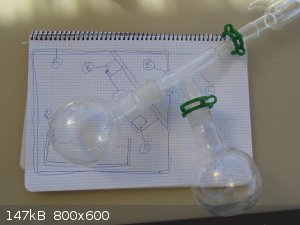
|
|
|
Dr.Bob
International Hazard
    
Posts: 2656
Registered: 26-1-2011
Location: USA - NC
Member Is Offline
Mood: No Mood
|
|
I don't get it, are you meaning that the glass joint is rotating between the rbf and the T joint? That just does not work in real life under a
vacuum, as glass joints will not rotate when under a vacuum, they are stuck pretty well.
Getting a rotating vacuum seal is not trivial, but it is not that hard, there are at least 10 designs for rotovaps that do that, many of which are
suitable for home building of some sort. Plus, there are used parts for cheap on Ebay. Building your new design might be more work than an already
tested design that is known to work. There are about 10 previous threads here on that subject, many have simple systems that work.
The other design is just more of a simple vacuum system with a good trap, and a hose to a RBF and you just stir the liquid magnetically and allow a
slow stream of air through it. A 2 or 3 necked flask would work fine with a sealed off Pasteur pipette as a capillary inlet.
|
|
|
aga
Forum Drunkard
    
Posts: 7030
Registered: 25-3-2014
Member Is Offline
|
|
The Neck of the RBF to the Left and the T piece do NOT touch, which allows rotation.
They are in close proximity though.
They will only be strongly pulled towards each other as the vacuum establishes.
After that the pressure will equalise, unless your solvent boils off faster than superman.
This eliminates the need for a rotating vacuum seal, and allows the use of standard condensers, and all standard glassware, and reducing Cost and
Complexity to as low as i can think how.
The only piece that is 'consumed' is the T-piece. The rest are all standard, and removable/reusable.
I have ordered a T-piece that will Fit my glassware (24/29-40), and will build one of these when it arrives.
The Point is to remove the need for machining skills, use what is already available, and at the lowest possible cost.
Reading more, i suspect the 'consumed' piece should be a Bump Trap rather than a T-piece.
|
|
|
chemrox
International Hazard
    
Posts: 2961
Registered: 18-1-2007
Location: UTM
Member Is Offline
Mood: LaGrangian
|
|
I've got a rotating joint with vac hookups I'll sell you for $250. All you need is a motor and aspirator plus a flask. There is no solvent collection
though...
"When you let the dumbasses vote you end up with populism followed by autocracy and getting back is a bitch." Plato (sort of)
|
|
|
aga
Forum Drunkard
    
Posts: 7030
Registered: 25-3-2014
Member Is Offline
|
|
Thanks for the offer chemrox.
i'll build my own Rotating Joint - Less rig for about $60 and see if it works.
... when the T-piece arrives.
I don't NEED a Rotavap at all currently, just intrigued by the idea, and how to make a cheap and simple one.
|
|
|
Dr.Bob
International Hazard
    
Posts: 2656
Registered: 26-1-2011
Location: USA - NC
Member Is Offline
Mood: No Mood
|
|
OK, I see what you are doing now. As long as the vacuum source connects to the condenser end and the box is sealed well, it might work. But it
involves a motor (they create sparks) in a sealed glass box filled with solvent vapor, so I don't like that part. Plus it will be hard to power the
motor then. But an interesting idea. I do think that there are simpler ways to do it.
|
|
|
arkoma
Redneck Overlord
      
Posts: 1761
Registered: 3-2-2014
Location: On a Big Blue Marble hurtling through space
Member Is Offline
Mood: украї́нська
|
|
A brushless induction motor ought to be sparkless.
"We believe the knowledge and cultural heritage of mankind should be accessible to all people around the world, regardless of their wealth, social
status, nationality, citizenship, etc" z-lib
|
|
|
aga
Forum Drunkard
    
Posts: 7030
Registered: 25-3-2014
Member Is Offline
|
|
I did consider the Sparkyness of the motor.
As arkoma says, Brushless motors do not spark
My most recent experience is with Only brushless motors (model helis).
In the rough sketch, the Motor is on the side of the glass where No solvent or product *should* get to.
That was for precisely that reason
There is this thing though, where Oxygen is needed for a Fire, and the motor and any Solvent/Product Vapour will be in a Vacuum.
As the title says, this is just an Idea at the moment, until the T-piece arrives.
Edit :
What simpler way ! Tell !
[Edited on 24-9-2014 by aga]
|
|
|
smaerd
International Hazard
    
Posts: 1262
Registered: 23-1-2010
Member Is Offline
Mood: hmm...
|
|
The most simple method that I saw was someone had a hollowed out DC motor rotor and they literally lead the vacuum through that and some how fixed the
motor to the flask (in a way that it wasn't horrendously dangerous). Now I wouldn't be putting diethyl ether in there or anything, but it was a simple
to the point design. I'd love to see what you come up with.
Not so sure what the purpose of the big glass box is for to be honest. Aside from that the only part of the design I'm not a big fan of is rotating
ground glass joints.
I am a big fan of how you plan to rotate the flask directly. Have you considered rotating the flask directly but placing some kind of teflon slips or
teflon adapters for the flask onto the T? Aside from that I think it's great(minus the glass box). If it work's I like this design better than my own.
|
|
|
aga
Forum Drunkard
    
Posts: 7030
Registered: 25-3-2014
Member Is Offline
|
|
Quote: Originally posted by smaerd  | I'm not a big fan of is rotating ground glass joints.
I am a big fan of how you plan to rotate the flask directly. Have you considered rotating the flask directly but placing some kind of teflon slips or
teflon adapters for the flask onto the T? Aside from that I think it's great(minus the glass box). If it work's I like this design better than my own.
|
Thanks. Encouraging words indeed from an Actual rotavap designer !
This is still merely an Idea though, at least until the straight T arrives.
The RBF joint would Not quite be touching, yet still be 'in' the cone of the end of the T-Piece.
This would allow free rotation of the RBF, but clearly not allow a vacuum.
The Box is sealed to the T-piece, and allows the space around the rotating joint to be brought to vacuum, effectively allowing vacuum to exist in the
whole system.
I forsee 3 problems. First is that the sealing of the box will be crucial, as will be the strength of the glass to withstand vacuum. Second is that
Bumping may well spray liquid from the RBF, and as the joint is not sealed, liquid may escape into the glass box. Thirdly, if the vacuum is pulled too
quickly, the RBF/T-Piece joint might be pulled into contact, and stick.
If it Does work, then the rotavap-specific apparatus will simply be a small glass box with a motor in it. Assembling the full rotavap would then just
need a standard condenser and two RBFs adding.
|
|
|
aga
Forum Drunkard
    
Posts: 7030
Registered: 25-3-2014
Member Is Offline
|
|
Minor update: Ordered more bits.
Found a cheaper straight connector to permanently attach to the glass box, which means the T can be used as a still head elsewhere.
RBF Clamp will be a rubber bushing made for a car, with the neck of the RBF shoved into it.
Bushing then shoved into a standard bearing (for a bicycle).
Bearing clamped to a sheet of HDPE with a hole in it.
Protruding part of the bushing belt driven by a motor.
How well does HDPE survive with organic solvents ?
|
|
|
aga
Forum Drunkard
    
Posts: 7030
Registered: 25-3-2014
Member Is Offline
|
|
Finally all the bits arrived (apart from the straight T piece).
The straight connector arrived broken, so more waiting.
The rubber bushing was rubbish. Way too hard, so there is Silicone sealant curing around a 250ml RBF today instead.
Photos to follow once it's taking shape.
Looks like it might actually work !
|
|
|
arkoma
Redneck Overlord
      
Posts: 1761
Registered: 3-2-2014
Location: On a Big Blue Marble hurtling through space
Member Is Offline
Mood: украї́нська
|
|
arkoma sheepishly reads this thread and realizes he NEEDS to go home
"We believe the knowledge and cultural heritage of mankind should be accessible to all people around the world, regardless of their wealth, social
status, nationality, citizenship, etc" z-lib
|
|
|
aga
Forum Drunkard
    
Posts: 7030
Registered: 25-3-2014
Member Is Offline
|
|
Tsk Tsk young arkomian.
|
|
|
Oxirane
Hazard to Self
 
Posts: 92
Registered: 19-9-2014
Member Is Offline
Mood: No Mood
|
|
You can make rotary seal with teflon and viton.
|
|
|
aga
Forum Drunkard
    
Posts: 7030
Registered: 25-3-2014
Member Is Offline
|
|
Motor/Sparks Solution:-
Extend the drive pulley axle to the wall of the glass and couple it magentically to a motor outside.
Same principle as a mag stirrer.
Zero electrics inside the glass box.
Incidentally, if this box nonsense works, you can have Long Hair and still use a rotyvap  It should be marginally Safer from the operator's point of view. It should be marginally Safer from the operator's point of view.
I have very little hair, so all the same to me.
[Edited on 27-10-2014 by aga]
|
|
|
aga
Forum Drunkard
    
Posts: 7030
Registered: 25-3-2014
Member Is Offline
|
|
Photos so far
Photos to show the 250ml RBF with silicone sealant as a Grip for a bicycle bearing, and the bearing itself.
By happy accident, the silicone sealant tube ID was a Perfect fit for the ID of the bearing, so i cut a 1" lump of that off and used it as a mold for
the silicone.
Mounted in the HDPE plate, the RBF rotates nicely !
(the hole i cut in the HDPE was a fraction too big for the bearing, so i melted bits of the circumference of the hole with a soldering iron, and now
it is a tight push-fit.)
Unfortunately i'll have to wait for the replacement glass to arrive before proceeding further.
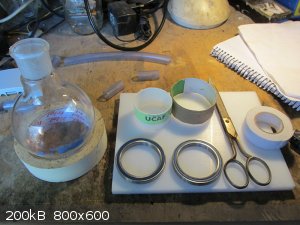 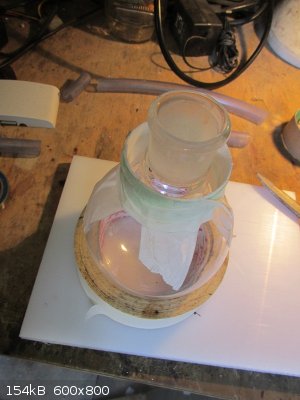 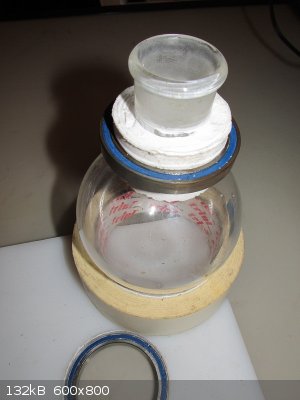 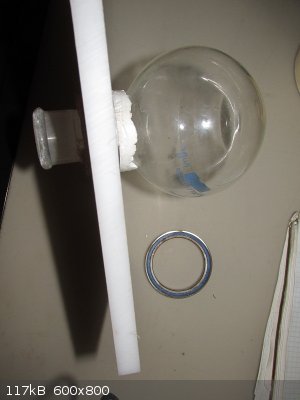
[Edited on 27-10-2014 by aga]
|
|
|
aga
Forum Drunkard
    
Posts: 7030
Registered: 25-3-2014
Member Is Offline
|
|
That would be great !
Would you please explain how?
|
|
|
Oxirane
Hazard to Self
 
Posts: 92
Registered: 19-9-2014
Member Is Offline
Mood: No Mood
|
|
You will need two mating pieces with teflon surfaces and a viton O-ring between them and then clamp them together. You can use normal ground joints
when you turn proper parts from teflon rod with lathe.
|
|
|
aga
Forum Drunkard
    
Posts: 7030
Registered: 25-3-2014
Member Is Offline
|
|
Not many people have a Lathe, or machining skills to turn an accurate slot or taper.
When the bits arrive, i'll finish the original idea, and then see if you can Improve it with a proper rotating vacuum seal.
If you can, then we can lose the glass box and hopefully make it even simpler/cheaper.
|
|
|
eesakiwi
Harmless

Posts: 27
Registered: 10-8-2005
Member Is Offline
Mood: drawnout
|
|
To tell the truth, the motor/gearbox part of a rotovap, which is the hardest part to get.
Is just a very overpriced version of a overpriced motor/gearbox unit that you can buy from almost any, actually any, company that sells ball bearing
races, electric motors and gearboxs.
Second hand would be a lot cheaper.
By just going into a shop that sells ball bearing races, look up their catalogue for what you want and its there.
You may have to figure out how to control the motor speed, easyish.
You might even find a exact copy of the real thing.
To raise and lower the unit. Get a small bench drill press 2nd hand.
The sort that you put a normal hand held electric drill into to make it a drill press.
Yard sales often have these, last two I found were chucked out in scrapmetal.
The bit you do need, is the long glass tube with a ground glass joint on its end.
And the rubber seal that mounts on the reduction geardrive and seals over the glass tube.
Then, well, the condensor that mounts over the seal. Unless you make a adaptor, your best chance is to buy one.
You will probably be able to buy the individual parts, like the seal will be a 'off the shelf' item. The adaptor to the condensor depends on the
condensor mount.
Normally they have a 'bolthead' end. There's a large dia nut that fits over/past that.
Then they slip over the bolthead, a coil spring that's been made into a circle.
Like a pen spring that's twisted into a circle and the ends inserted into each other.
But a solid spring, closed coils, so you can't see thru it sideways.
That fits into behind the bolthead and the nut screws onto the gearbox head and pushes the spring, which pushes the bolthead against the seal.
[Edited on 28-10-2014 by eesakiwi]
|
|
|
smaerd
International Hazard
    
Posts: 1262
Registered: 23-1-2010
Member Is Offline
Mood: hmm...
|
|
Also aga I would like to correct your original post. My rotary evaporator does have a vacuum and I am not S.C. Wack hehehe.
|
|
|
| Pages:
1
2 |